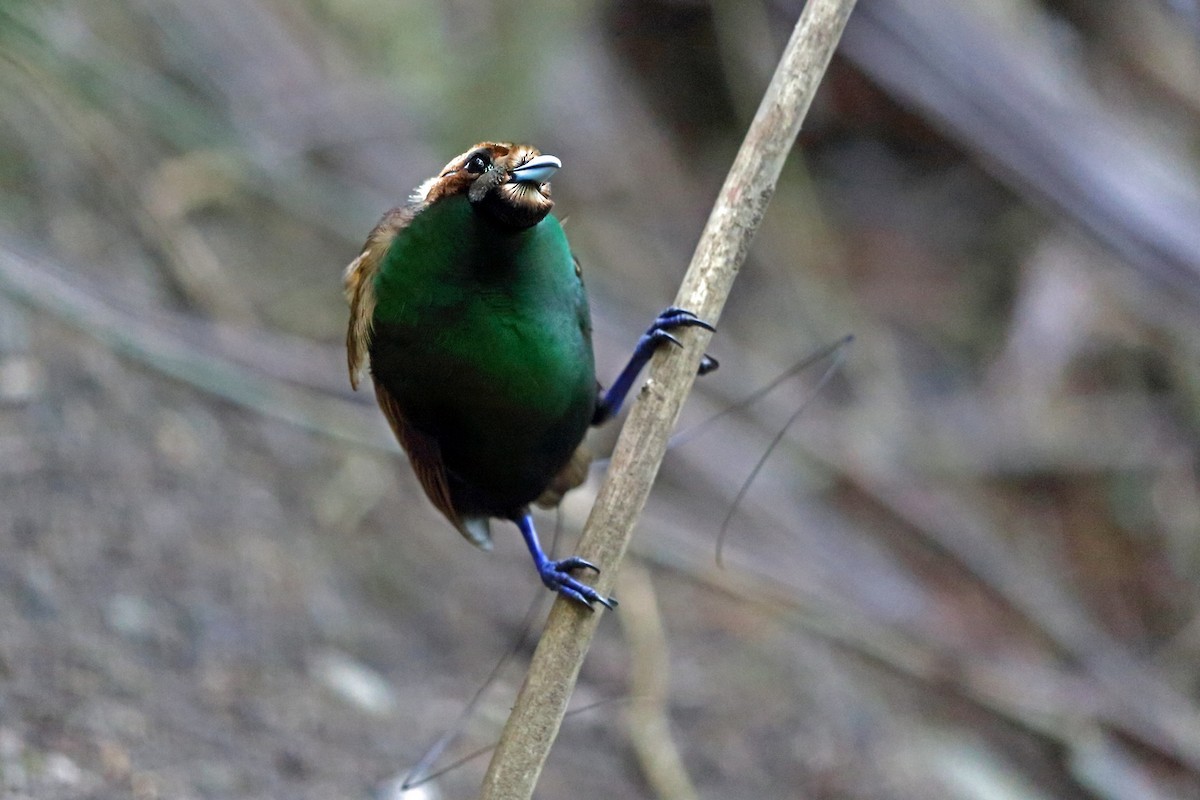Magnificent Bird-of-paradise
A species of Diphyllodes Scientific name : Diphyllodes magnificus Genus : Diphyllodes
Magnificent Bird-of-paradise, A species of Diphyllodes
Botanical name: Diphyllodes magnificus
Genus: Diphyllodes
Content
Description General Info
 Photo By Nigel Voaden
Photo By Nigel Voaden Description
As the name suggests, the magnificent bird-of-paradise is magnificent indeed. It has one of the most complex plumage arrangements in the family Paradisaeidae. It reaches around 26–26.5 cm in total length, though the body is around 19 cm. The male has beautiful golden-yellow wings, which are overlapped by a sulfur-colored mantle, or cape, that deflect white a whitish glow, with deep red feathers bordered by black beneath the cape that form a semi-circle over the wings; there are also scruffy brownish feathers on the sides of the cape. The head is fairly short; it is a light brown in a scalloped pattern on the top that extends to the back of the neck, and a darker reddish-brown on the face and below the chin. It has a pale grey-bluish bill, dark brown eyes and a thin, white line that extend behind the eyes. Below is an entirely different story; almost the entire underside consists of the large, iridescent green breast shield, which is finely decorated with lime-green to turquoise scale-like feathers that run down the middle of it. The plumage under the shield is blackish-brown. When fully extended, the breast shield is edged with shiny turquoise-greenish. The tail is blackish-brown with two long, sickle-like, partially curved central tail plumes that are colored light blue. As characteristic in the genus Cicinnurus, both sexes have colorfully blue legs and feet. The female is drastically different from the extravagant male; she is light-brown above, including the tail (which lacks the long sickles). Her head is light brown, but the chin is intercepted by brown barring and creamy feathers that extend all the way to the rump. Her bill is the same color as the males', and she also has a white line extending behind the eyes. It is sympatric with its congener, the King Bird-of-paradise, and hybridization has been noted several times. Over 20 specimens of these hybrids exist in museums, though no wild records have ever occurred. It was once even thought to be a separate species, called King of Holland's Bird-of-paradise ("Diphyllodes gulielmitertii"); this hybrid is scarlet red above, of the King, with the golden mantle cape of the Magnificent, also sporting two long tail wires more resembling the king's, but being partially curved at the tip with no green spirals that the king sports. 
Size
19 cm
Nest Placement
Tree
Feeding Habits
Magnificent Bird-of-paradise consumes fruits and a range of animals, particularly insects and araneae. Nestlings are fed fruits. Magnificent Bird-of-paradise forages alone, mainly in lower forest layers, occasionally in mixed-species groups.
Habitat
The magnificent Bird-of-paradise typically inhabits undisturbed hill forests and lower montane regions, occasionally venturing into hilly lowland rainforests. These birds favor steep slopes and areas that have undergone natural disturbances such as treefalls or landslips, where gaps in the forest canopy create ideal conditions for their courtship displays.
Dite type
Frugivorous
General Info
Feeding Habits
Bird food type

Fruit
Behavior
They tend to favor tropical and subtropical montane and hill forest at altitudes of around 1500 m, though they can be found around 1780 m as well. They build their courts on rugged slopes of rocky and uneven terrain. The birds feed mainly on fruits, but also feed on animal matter (notably insects, reptiles and amphibians), and possibly take nectar and flowers. They mainly feed solitarily, but may also feed in mixed-species congregations. The courtship display of the male is very unique in its family. It typically takes place on a sapling standing up from the ground. He commonly tends to his court and makes sure it stays clean and clear of fallen debris. When a female attends his court, he is usually on his display perch. Here is where he does his display; he leans backwards to point where his body is perpendicular to the sapling, raises his mantle cape, to where it appears like a yellow halo behind his head, expands and flexes his iridescent breast shield, and waggles his sickle-shaped tail on each side. Though this performance is comical, it is often observed by many females nearby, who do not take the male mating with the core audience member too lightly. When the male is about to copulate the core female, other females nearby will spring from their perches to attack and shoe off the female, and the male is discouraged and may have to wait a while to perform again. Typical of most of the bird-of-paradise family, the female takes up all parental duties, including nest-building, incubation and chick-rearing. They lay one to two creamy yellow eggs, and incubation usually concludes within 19 days, and the chicks usually fledge in 18 days. 

 Photo By Nigel Voaden
Photo By Nigel Voaden Scientific Classification
Phylum
Chordates Class
Birds Order
Perching birds Family
Birds-of-paradise Genus
Diphyllodes Species
Magnificent Bird-of-paradise